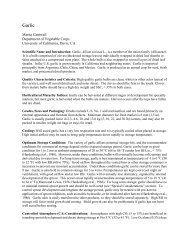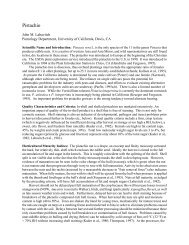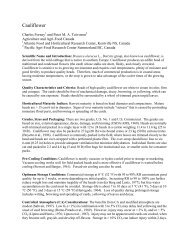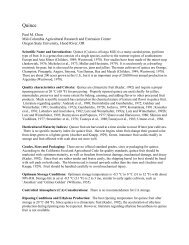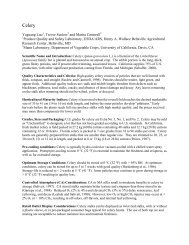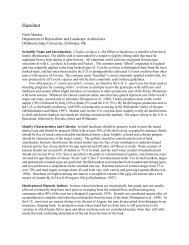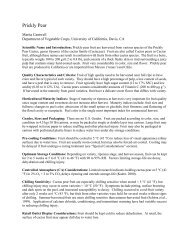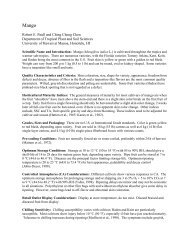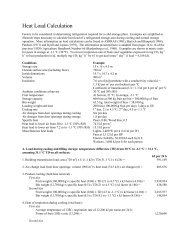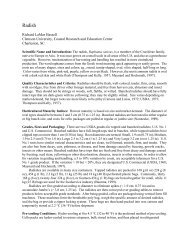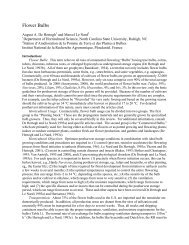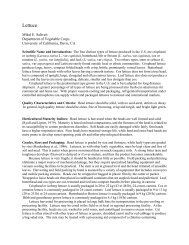Carrot
Carrot
Carrot
Create successful ePaper yourself
Turn your PDF publications into a flip-book with our unique Google optimized e-Paper software.
<strong>Carrot</strong><br />
Yaguang Luo 1 , Trevor Suslow 2 and Marita Cantwell 2<br />
1 Produce Quality and Safety Laboratory, USDA/ARS, Henry A. Wallace Beltsville Agricultural<br />
Research Center, Beltsville, MD<br />
2 Mann Laboratory, Department of Vegetable Crops, University of California, Davis, CA<br />
Scientific Name and Introduction: <strong>Carrot</strong>s (Daucus carata L.) are biannuals of the Apiaceae<br />
(Umbelliferae) family. The edible portion is the storage taproot, which contains high levels of<br />
carbohydrates (sugars) and ß-carotene (pre-vitamin A). Most of the carrots in U.S. markets are produced in<br />
California complemented by limited production in Michigan, Texas, Colorado, Florida and Washington<br />
(Schaffer, 2000), and are available year round.<br />
Quality Characteristics and Criteria: Quality criteria vary with the end usage. In general, high quality<br />
carrots are firm, straight from “shoulder” to “tip,” smooth with little residual “hairiness,” sweet with no<br />
bitter or harsh taste, and show no signs of cracking or sprouting (Suslow and Cantwell, 1998).<br />
Horticultural Maturity Indices: Harvest maturity varies with the market outlet and the end usage. For<br />
fresh market, most carrots are harvested partially mature, when the roots are about 1.8 cm (0.75 in) or larger<br />
in diameter at the upper end (Kotecha et al., 1998). Late harvesting may improve storability by reducing<br />
decay during extended storage (Suojara, 1999). For fresh-cut processing, carrots are harvested immature to<br />
insure they are tender and sweet.<br />
Grades, Sizes and Packaging: <strong>Carrot</strong>s can be harvested either bunched or top trimmed; top trimmed is the<br />
dominant method. The common grades for bunched carrots are No. 1 and commercial grade. For topped<br />
carrots, the grades are extra No. 1, U.S. No. 1, No. 1 Jumbo, and No. 2. Topped carrots are typically packed<br />
in 0.5 to 2.25 kg (1 to 5 lb) consumer bags that are grouped in 11 or 22 to 22.7 kg (24 or 48 to 50 lb) cartons<br />
or master poly bags. Bunched carrots are packed loosely in 12 kg (26 lb) cartons.<br />
Pre-cooling conditions: Prompt washing and hydro-cooling to < 5 °C (41 °F) is essential to maintain carrot<br />
freshness and crispness. Typically, carrots pass through several wash and flume steps that remove field heat<br />
and are then hydrocooled in chlorinated water before packing.<br />
Optimum Storage Conditions: Storage temperature at 0 to 1 °C (32 to 33.8 °F) is essential to minimize<br />
decay and sprouting during storage. High RH is required to prevent desiccation and loss of crispness. The<br />
recommended conditions for commercial storage are 0 °C (32 °F) with 98 to 100% RH. Under this<br />
condition, mature topped carrots can be stored for 7 to 9 mo. However, commercial storage and distribution<br />
condition rarely achieve the optimum storage conditions and topped carrots can be stored for 5 to 6 mo at<br />
0 °C (32 °F) to 5 °C (41 °F) with 90 to 95% RH. Common “Cello-pack” carrots are typically immature and<br />
may be stored successfully for 2 to 3 weeks at 3 to 5 °C (37.4 to 41 °F). Bunched carrots are highly<br />
perishable due to the presence of leaves and can be maintained for only 8 to 12 days. Bunched carrots are<br />
typically shipped and stored with shaved or flake-ice.<br />
Controlled Atmosphere (CA) Considerations: CA generally does not extend storage-life of carrots<br />
beyond that in air with high RH (Leshuk and Saltveit, 1990). Low O 2 (1%) inhibited sprouting, but also<br />
promoted decay (Abdel-Rahman and Isenberg, 1974). CO 2 injury appears as soft brown spots upon<br />
exposure to air. CO 2 levels > 5% promote decay. Storage at < 3% O 2 can result in increased bacterial rot,<br />
off-flavors, and off-odors (Leshuk and Saltveit, 1990).
Retail Outlet Display Considerations: <strong>Carrot</strong>s are often displayed loosely on a shelf with mist or in<br />
polyethylene consumer packages.<br />
Chilling Sensitivity: <strong>Carrot</strong>s are not chilling sensitive and should be stored as cold as possible without<br />
freezing. Their freezing point is -1.2 °C (29.8 °F).<br />
Ethylene Production and Sensitivity: <strong>Carrot</strong>s produce very low ethylene at < 0.1 µL kg -1 h -1 at 20 °C (68<br />
°F). Exposure to exogenous ethylene (~ 0.2 µL L -1 ) will induce development of isocoumarin and bitter<br />
flavor (Lafuente et al., 1996; Talcott and Howard, 1999). Induction and accumulation of isocoumarins is<br />
greatest on cut but not yet peeled carrot sections. Exposure of peeled carrot to ethylene does not result in<br />
development of bitterness. Thus, whole or sectioned carrots should not be mixed in storage with<br />
ethylene-producing commodities.<br />
Respiration Rates:<br />
Temperature Topped Bunched<br />
(mg CO 2 kg -1 h -1 )<br />
0 °C 10 to 20 18 to 35<br />
5 °C 13 to 26 25 to 51<br />
10 °C 20 to 42 32 to 62<br />
15 °C 26 to 54 55 to 106<br />
20 °C 46 to 95 87 to 121<br />
To get mL kg -1 h -1 , divide the mg kg -1 h -1 rate by 2.0 at 0 °C (32 °F), 1.9 at 10 °C (50 °F), and 1.8 at 20 °C<br />
(68 °F). To calculate heat production, multiply mg kg -1 h -1 by 220 to get BTU per ton per day or by 61 to<br />
get kcal per metric ton per day. Data from Hardenburg et al. (1986).<br />
Physiological Disorders: Bruising, shatter-cracks, longitudinal cracking, and tip-breakage are signs of<br />
excessively rough handling. Nantes-type carrots are particularly susceptible to mechanical damage<br />
(McGarry, 1993). The severity of shatter-cracking is partially related to varietal background. Wilting,<br />
shriveling, and rubberiness are signs of moisture loss. Sprouting may occur on topped carrots if the storage<br />
temperature is too high. Bitterness can develop in storage due to the accumulation of isocoumarin, caused<br />
by disease or exposure to ethylene. Harsh flavor may be caused by the high terpenoid content, generally<br />
from pre-harvest water stress. Surface browning or oxidative discoloration often develops during storage,<br />
especially on carrots harvested when immature.<br />
Postharvest Pathology: The most prominent storage decays are bacteria soft rot (induced by<br />
Pectobacterium carotovora or Pseudomonas marginalis), gray mold rot (Botrytis cinerea), Rhizopus soft<br />
rot (Rhizopus spp.), watery soft rot (Sclerotinia sclerotiorum), and sour rot (Geotrichum candidum)<br />
(Snowden, 1992). Ozone is a fungistatic against Botrytis and Sclerotinia, but tissue damage and color loss<br />
occur after treatment (Liew and Prange, 1994). Good sanitation during packing and storing 0 °C (32 °F) are<br />
most important to minimize postharvest diseases.<br />
Quarantine Issues: None<br />
Suitability as Fresh-cut Product: A significant portion of fresh carrot production is used to produce<br />
fresh-cut products such as “baby carrots,” carrot coins, shreds, and sticks. <strong>Carrot</strong>s directed or consigned to<br />
fresh-cut processing are typically harvested at an immature stage for optimal texture and taste. Fresh-cut<br />
carrots typically have a shelf-life of 3 to 4 weeks at 0 °C (32 °F) and 2 to 3 weeks at 3 to 5 ºC (37 to 41 °F).<br />
“White blush” has remained a problem for processors and shippers of fresh-cut carrots. The superficial<br />
whiteness is caused by dehydration of the cut surface (Cisneros-Zevallos et al., 1995). Low storage
temperature and the presence of residual surface moisture significantly delays development of this disorder.<br />
Using sharp knives is important to reduce tissue damage and extend shelf-life (Barry-Ryan and O’Beirne,<br />
1998).<br />
References:<br />
Abdel-Rahman, and Isenberg, F.M.R. 1973. Effect of growth regulators and controlled atmosphere on<br />
stored carrots. J. Agric. Sci., 53:635.<br />
Barry-Ryan, C. and D. O’Beirne. 1998. Quality and shelf-life of fresh-cut carrot slices as affected by slicing<br />
method. J. Food Sci. 63:851-856.<br />
Cisneros-Zevallos, L., M. Saltveit and J. Krochta. 1995. Mechanism of surface white discoloration of<br />
peeled (minimally processed) carrots during storage. J. Food Sci. 60:320-323, 333.<br />
Hardenburg, R.E., A.E. Watada, and C.Y. Wang. 1986. The commercial storage of fruits, vegetables and<br />
florist and nursery stocks. USDA Agric. Hndbk. No. 66, Washington, D.C.<br />
Kotecha, P.M., B.B. Desai and D.L. Madhavi. 1998. <strong>Carrot</strong>. In: D.K. Salunke and S.S. Kadam (eds)<br />
Handbook of Vegetable Science and Technology. Marcel Dekker, NY, pp.119-139.<br />
Lafuente, M.T., G. López-Gálvez, M. Cantwell and S.F. Yang. 1996. Factors influencing ethylene-induced<br />
isocoumarin formation and increased respiration in carrots. J. Amer. Soc. Hort. Sci. 121:537-542.<br />
Leshuk, J.A. and M.E. Saltveit Jr. 1990. Controlled atmosphere storage requirements and recommendations<br />
for vegetables. In: M. Calderon and R. Barkai-Golan (eds) Food Preservation by Modified<br />
Atmospheres. CRC Press, Boca Raton FL, pp. 315-352.<br />
Liew, C.L. and R.K. Prange. 1994. Effect of ozone and storage temperature on postharvest diseases and<br />
physiology of carrots (Daucus carota L.). J. Amer. Soc. Hort. Sci. 119: 5673-567.<br />
Mazza, G. 1989. <strong>Carrot</strong>s. In: N.A.M. Eskin (ed) Quality and Preservation of Vegetables. CRC Press, Boca<br />
Raton FL, pp.75-119.<br />
McGarry, A. 1993. Influence of water status on carrot (Daucus carota L.) fracture properties. J. Hort. Sci.<br />
68:431-437.<br />
Shaffer, E. (ed) 2000. Produce availability and merchandising guide. The Packer, Vance Pub., Lenexa KS.<br />
Snowdon, A.L. 1992. Color atlas of postharvest diseases and disorders of fruits and vegetables. Vol. 2, CRC<br />
Press, Boca Raton FL, pp. 268-293.<br />
Suojara, T. 1999. Effect of harvest time on the storage performance of carrot. J. Hort. Sci. Biotech. 74:<br />
484-492.<br />
Suslow, T., J. Mitchell and M. Cantwell. 1998. <strong>Carrot</strong> Produce Facts. Recommendations for Maintaining<br />
Postharvest Quality. http://postharvest.ucdavis.edu/produce.<br />
Talcott, S.T. and L.R. Howard. 1999. Determination and distribution of 6-methoxymellein in fresh and<br />
processed carrot puree by a rapid spectrophotometric assay. J. Agric. Food Chem. 47:3237-3242.



